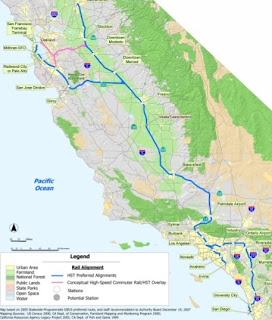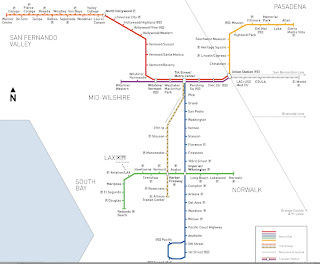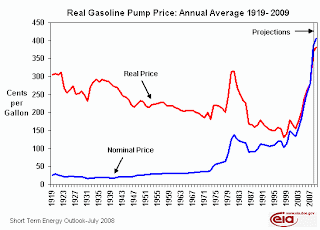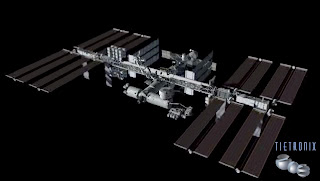
I was about 100 feet under downtown Los Angeles, when the earthquake hit.
On Tuesdays I commute from North Hollywood station all the way down to Long Beach to volunteer at the aquarium, using the Red line (L.A.'s only completely subterranean heavy rail) and the Blue line (a light rail that is only underground breifly at its northernmost station).
I think we were somewhere between Vermont/Santa Monica and 7th/Metro (where I disembarked) at the time of the quake. The reason I am unsure exactly where on the route we were at 11:42 am is because I DIDN'T FEEL THE EARTHQUAKE AT ALL. No one in my train car did, as far as I can recall. I do remember that, at one of the red line stops, the train was stopped for longer than usual (maybe 30 seconds), and the conductor said something inaudible over the speaker, but I didn't know what it was, and it didn't seem to matter much since we were moving again pretty quick, so I assumed it was some random delay. No one around me was reacting to anything (several were sleeping), so I think it's not just me on the train that didn't feel it.
(I am actually curious at why I didn't feel the quake on the red line. Was it simply because the regular vibrations felt when riding the train masked the vibrations from the quake? The red line feels (to me) like it has shocks cushioning between the wheel chassis and the car somehow, making it a smooth ride. Did those shocks (if they exist) damp out the jolt of the quake as well? I dunno.)
After disembarking the red line at 7th/Metro, I went up the stairs to wait for the Blue Line. This station is a double-decker subway station, with the red line at the lower level and the blue line at the upper level, but both still underground. After waiting 3 or 4 minutes, someone came on the station loudspeaker and said "(something inaudible) We are running all trains as normal, but (something inaudible) there may be some delays. We appreciate your patience and apologize for any inconvenience."
I was playing a stupid game on my phone, so I wasn't really paying attention, and figured there was some random reason why the trains might be delayed. This didn't seem all that unusual, so I just waited as normal.
The blue line train showed up only a few minutes or so later than expected. I strolled onboard, still blissfully unaware that anything had happened. It was now around 11:55 or so. Once people had mostly sat down and had gotten quiet, the conductor for this train came on the loudspeaker:
"This train will be departing for Long Beach. Because of the earthquake, we will not be traveling faster than 15 miles per hour. We apologize for any inconvenience this may cause."
Earthquake? There was an earthquake? Huh.
I pulled out my shiny new iphone, which of course gets no reception underground, and opened the web browser. As soon as we emerged from underground and were approaching Pico station, I went to CNN.com. On the top of the CNN front page was an alert in big red letters: "5.4 Earthquake rocks Los Angeles. Details soon."
Yeesh, I thought, talk about alarmist reporting! Here CNN is warning the nation of a natural disaster possibly destroying L.A., and here I am coming out from beneath downtown L.A. and I didn't even feel the darn thing. I then browsed over to the USGS web site and found out that it was indeed a 5.4 quake, whose epicenter was near Chino Hills, about 30 miles east-southeast of downtown. I figured, well, maybe it was too far away for us to feel it. Right then I get a text message from my sister in SAN DIEGO. "Did you feel the earthquake?", she asked. I responded that I hadn't, and she immediately replied that the room she was in (a classroom in a larger building) was "rockin' and rollin'". In San Diego. 113 miles from the epicenter! Everyone else I talked to that day definitely felt the earthquake. In a weird way, I feel sort of left out.
The main impact it had on my day was that the blue line was forced to run much slower, I guess as a safety precaution in case of aftershocks. We were going 15 mph most of the 30 or so miles to Long Beach. I could hear chatter on the speakers, which sounded like communications between the conductor and higher authorities. By the time we were street-running in Long Beach, it sounded like the conductor was given approval to take the train up to 45 mph, but at that point it was moot for me, since we were stopping at stoplights and such anyway. The 53 minute scheduled ride between 7th/Metro and the Long Beach Transit Mall instead took about 1 hr 40 minutes. Luckily I could call the aquarium and let them know I would be late so someone could cover for the first part of my volunteer shift.
While I was checking out news sites for more quake info, some guy sat down next to me, having just boarded at Pico. I asked him if he felt the quake. "Oh yeah," he said. Then he noticed that the train was going really slow, and I told him that it was for safety. He realized that, at this rate, he was not going to make to where he was going by using the train, so I used my iPhone and the MTA website to figure out an alternate route for him to take, using a bus that was scheduled to stop at the next blue line station we'd be stopping at in just a few minutes! Worked out kind of well, and he walked off the train saying "I need to get me one of those!". So I guess these things aren't just toys afterall.



